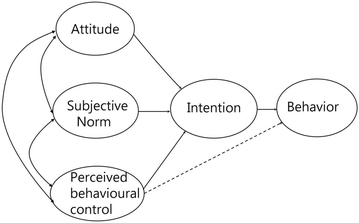Hospital nurses' attitudes, negative perceptions, and negative acts regarding workplace bullying
- PMID: 28936227
- PMCID: PMC5603093
- DOI: 10.1186/s12991-017-0156-0
Hospital nurses' attitudes, negative perceptions, and negative acts regarding workplace bullying
Abstract
Background: Workplace bullying is a prevalent problem in today's work places that has adverse effects on both bullying victims and organizations. To investigate the predictors of workplace bullying is an important task to prevent bullying victims of nurses in hospitals.
Objective: This study aims to explore the relationships among nurses' attitudes, negative perceptions, and negative acts regarding workplace bullying under the framework of the theory of planned behavior (TPB).
Methods: A total of 811 nurses from three hospitals in Taiwan were surveyed. Nurses' responses to the 201 items of 10 scales were calibrated using Rasch analysis and then subjected to path analysis with partial least-squares structural equation modeling (PLS-SEM).
Results: The instrumental attitude was significant predictors of nurses' negative perceptions to be bullied in the workplace. Instead, the other TPB components of subjective norm and perceived behavioral control were not effective predictors of nurses' negative acts regarding workplace bullying.
Conclusions: The findings provided hospital nurse management with important implications for prevention of bullying, particularly to them who are tasked with providing safer and more productive workplaces to hospital nurses. Awareness of workplace bullying was recommended to other kinds of workplaces for further studies in future.
Keywords: Partial least squares structural equation modeling; Path analysis; Rasch measurement; Theory of planned behavior; Workplace bullying.
Figures
Similar articles
-
Applying computerized adaptive testing to the Negative Acts Questionnaire-Revised: Rasch analysis of workplace bullying.J Med Internet Res. 2014 Feb 17;16(2):e50. doi: 10.2196/jmir.2819. J Med Internet Res. 2014. PMID: 24534113 Free PMC article.
-
Workplace bullying among nurses and their related factors in Japan: a cross-sectional survey.J Clin Nurs. 2016 Sep;25(17-18):2478-88. doi: 10.1111/jocn.13270. Epub 2016 Jul 7. J Clin Nurs. 2016. PMID: 27383562
-
Nurses' perceptions of teamwork and workplace bullying.J Nurs Manag. 2018 May;26(4):411-419. doi: 10.1111/jonm.12554. Epub 2018 Jan 22. J Nurs Manag. 2018. PMID: 29356193
-
Workplace bullying in the nursing profession: A cross-cultural scoping review.Int J Nurs Stud. 2020 Nov;111:103628. doi: 10.1016/j.ijnurstu.2020.103628. Epub 2020 May 15. Int J Nurs Stud. 2020. PMID: 32932063
-
New graduate registered nurses' exposure to negative workplace behaviour in the acute care setting: An integrative review.Int J Nurs Stud. 2019 May;93:41-54. doi: 10.1016/j.ijnurstu.2018.09.020. Epub 2019 Feb 20. Int J Nurs Stud. 2019. PMID: 30861453 Review.
Cited by
-
Effects of a Workplace Violence Intervention on Hospital Employee Perceptions of Organizational Safety.J Occup Environ Med. 2020 Dec;62(12):e716-e724. doi: 10.1097/JOM.0000000000002036. J Occup Environ Med. 2020. PMID: 33003045 Free PMC article.
-
An app for predicting nurse intention to quit the job using artificial neural networks (ANNs) in Microsoft Excel.Medicine (Baltimore). 2022 Mar 18;101(11):e28915. doi: 10.1097/MD.0000000000028915. Medicine (Baltimore). 2022. PMID: 35356900 Free PMC article.
-
Attitude to COVID-19 Prevention With Large-Scale Social Restrictions (PSBB) in Indonesia: Partial Least Squares Structural Equation Modeling.Front Public Health. 2020 Oct 30;8:570394. doi: 10.3389/fpubh.2020.570394. eCollection 2020. Front Public Health. 2020. PMID: 33194970 Free PMC article.
-
Assessing Related Factors of Intention to Perpetrate Dating Violence among University Students Using the Theory of Planned Behavior.Int J Environ Res Public Health. 2020 Feb 2;17(3):923. doi: 10.3390/ijerph17030923. Int J Environ Res Public Health. 2020. PMID: 32024264 Free PMC article.
-
Factors Related to Intentions to Commit Dating Violence among Taiwanese University Students: Application of the Extended Theory of Planned Behavior.Int J Environ Res Public Health. 2021 Feb 17;18(4):1956. doi: 10.3390/ijerph18041956. Int J Environ Res Public Health. 2021. PMID: 33671426 Free PMC article.
References
-
- Rayner C, Keashley L. Bullying at work: a perspective from Britain and North America. In: Fox S, Spector PE, editors. Counterproductive work behavior: investigations of actors and targets. Washington, DC: American Psychological Association; 2005. pp. 271–296.
-
- Einarsen S, Hoel H, Notelaers G. Measuring exposure to bullying and harassment at work: validity, factor structure and psychometric properties of the negative acts questionnaire-revised. Work Stress. 2009;23(1):24–44. doi: 10.1080/02678370902815673. - DOI
-
- Leymann H. The content and development of mobbing at work. Eur J Work Organ Psychol. 1996;5(2):165–184. doi: 10.1080/13594329608414853. - DOI
-
- Chen LM, Liu KS, Cheng YY. Validation of the perceived school bullying severity scale. Educ Psychol. 2012;32(2):169–182. doi: 10.1080/01443410.2011.633495. - DOI
-
- Rayner C, Cooper CL. Workplace bullying. In: Kelloway E, Barling J, Hurrell J Jr, editors. Handbook of workplace violence. Thousand Oaks: Sage; 2006. pp. 47–90.
LinkOut - more resources
Full Text Sources
Other Literature Sources



